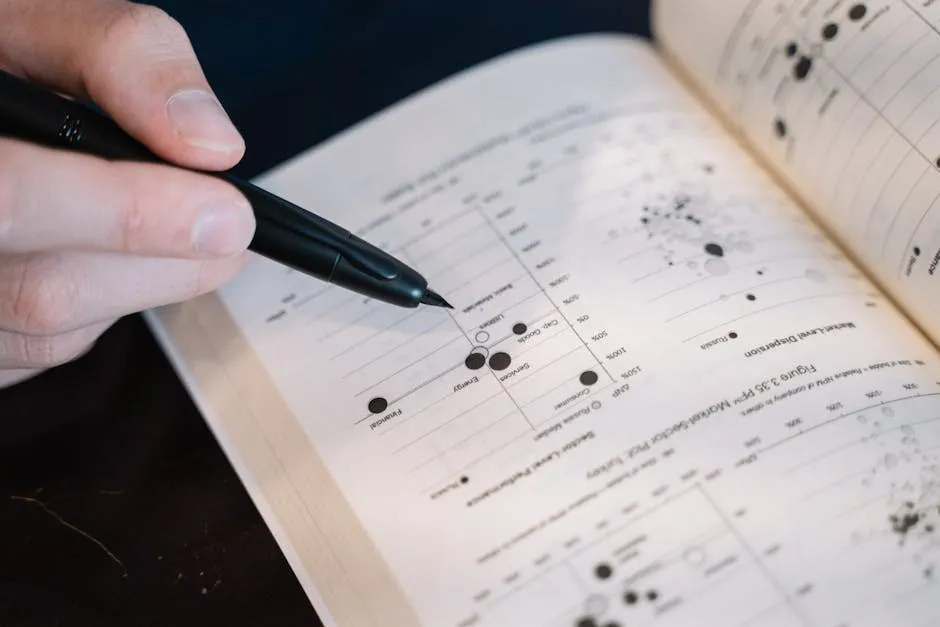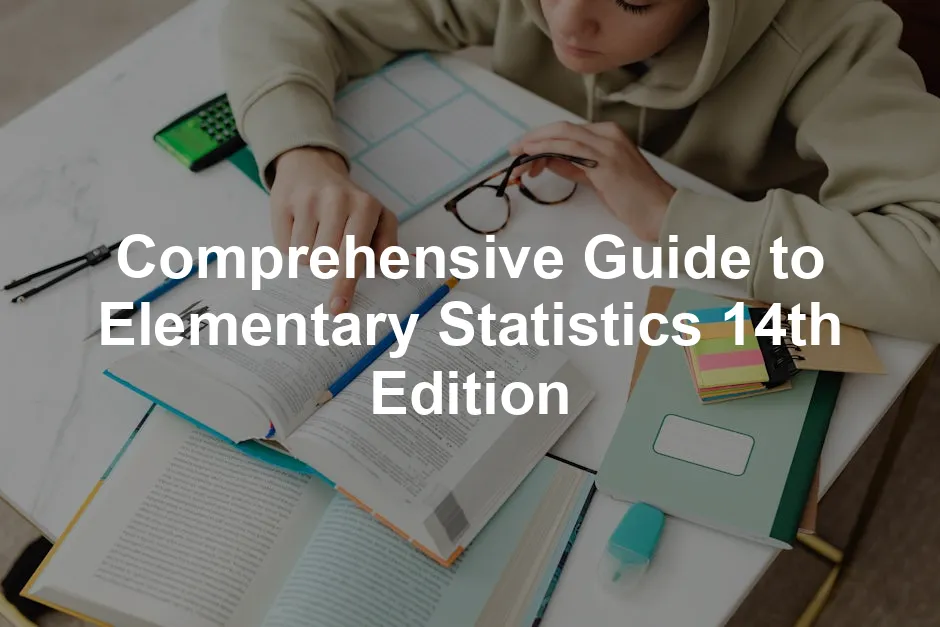Introduction
Statistics is everywhere. It’s the backbone of countless fields like economics, psychology, healthcare, and even sports! Whether you’re analyzing trends or making data-driven decisions, understanding statistics is essential. Enter the 14th edition of “Elementary Statistics” by Mario F. Triola—a brilliant resource that demystifies statistical concepts for students and professionals alike.
This edition is not just a textbook; it’s a treasure trove of information. Triola’s engaging writing style makes complex topics accessible. Expect plenty of real-world examples that breathe life into the numbers. From calculating probabilities to understanding distributions, this book equips you with the tools to tackle statistical challenges head-on. If you want to dive deeper into the subject, check out Elementary Statistics by Mario F. Triola (14th Edition).
In this article, we’ll provide you with an overview of the book, highlight key features, discuss pricing options, and compare it to previous editions. So, grab your favorite snack and let’s dive into the fascinating world of elementary statistics!

Overview of Elementary Statistics
What is Elementary Statistics?
Elementary statistics is the study of basic statistical concepts and techniques. This field covers crucial areas such as data organization, interpretation, and analysis. In academic settings, it often serves as the introductory course that lays the groundwork for more advanced statistical studies.
Triola’s textbook plays a vital role in these introductory courses. It breaks down complex theories into bite-sized pieces, making learning smooth and enjoyable. With clear explanations and plenty of practice problems, students can grasp foundational concepts without feeling overwhelmed. This approach not only enhances comprehension but also builds confidence in applying statistical methods in real-life scenarios. For those looking to explore statistical inference, Statistical Inference by George Casella is a great companion book!
Author Background
Mario F. Triola is a name that resonates in the world of statistics education. With a rich background in teaching and a passion for making statistics approachable, he has authored numerous textbooks that have gained widespread acclaim. His work is characterized by a commitment to clarity and engagement, making him a favorite among students and educators alike.
Triola’s contributions to statistics education extend beyond textbooks. He’s recognized for his innovative teaching methods and has received accolades for his ability to connect with learners. His dedication to fostering a love for statistics has not gone unnoticed—Triola has been awarded several honors for his work, including recognition from educational institutions. With the 14th edition of “Elementary Statistics,” he continues to inspire a new generation of statisticians.
This book not only reflects Triola’s expertise but also his genuine desire to make statistics a fun and relevant subject. In today’s data-driven world, having a solid grasp of statistics is invaluable, and Triola’s work helps pave the way for success in this exciting field. If you’re curious about a different approach, check out The Art of Statistics: Learning from Data by David Spiegelhalter.

Detailed Breakdown of the 14th Edition
Key Features
The 14th edition of “Elementary Statistics” by Mario F. Triola is not just a simple update; it’s a full-on upgrade! This edition incorporates fresh datasets and examples that reflect current trends like cybersecurity and drone technology. For instance, students can now analyze data related to the rising concerns in cybersecurity, making statistics not only relevant but crucial in today’s digital landscape. The inclusion of real-world applications helps bridge the gap between theory and practice, making statistical concepts more relatable and engaging.
Learning tools? Oh, they’ve got plenty! With the textbook, you gain access to MyLab Statistics Access Code, an interactive platform that enhances your learning experience. This resource provides instant feedback on assignments, along with personalized learning paths tailored to your pace. Video tutorials further enrich the learning process, allowing you to grasp complex concepts through visual aids. You’ll also find a plethora of practice problems that cater to various skill levels, ensuring that every student finds a suitable challenge.

Table of Contents Overview
The structure of the 14th edition is designed for clarity and ease of navigation. Here’s a glimpse at the major sections and chapters:
1. Introduction to Statistics – Covers statistical concepts and critical thinking.
2. Exploring Data with Tables and Graphs – Focuses on organizing and summarizing data through various graphical representations.
3. Describing, Exploring, and Comparing Data – Introduces measures of center and variation.
4. Probability – Discusses basic concepts, rules, and simulations related to probability.
5. Discrete Probability Distributions – Covers binomial and Poisson distributions.
6. Normal Probability Distributions – Explains the standard normal distribution and its applications.
7. Estimating Parameters and Determining Sample Sizes – Discusses point estimation and sample size calculations.
8. Hypothesis Testing – Introduces the basics and practices for testing claims about populations.
9. Inferences from Two Samples – Focuses on comparing two samples through various statistical methods.
10. Correlation and Regression – Discusses relationships between variables and prediction models.
11. Goodness-of-Fit and Contingency Tables – Analyzes categorical data and its distributions.
12. Analysis of Variance (ANOVA) – Explores methods for comparing means among multiple groups.
13. Nonparametric Tests – Covers tests that don’t assume a specific distribution.
14. Statistics Process Control – Discusses control charts and their applications in quality assurance.
15. Holistic Statistics – Encourages a comprehensive approach to statistical analysis.

Accessibility and Usability
The textbook is designed with usability in mind. Its layout is clean, making it easy to read and navigate. The font size and spacing enhance readability, ensuring that students can focus on learning without straining their eyes.
Moreover, accessibility features are integrated throughout the textbook. The eTextbook option offers screen-reader compatibility, text reflow for easier reading, and the ability to highlight and annotate directly on the digital pages. This flexibility caters to diverse learning styles and needs, making it an excellent choice for students with different preferences.
The print version is just as user-friendly, allowing students to jot down notes in the margins and highlight key concepts. Whether you prefer flipping through pages or scrolling on a screen, this textbook has you covered! If you’re interested in a more visual approach to data, consider Data Visualization: A Practical Introduction by Kieran Healy.

In conclusion, the 14th edition of “Elementary Statistics” by Mario F. Triola is packed with updated content, practical learning tools, and a user-friendly design that makes mastering statistics a breeze. With its current examples and accessible layout, students are set up for success in their statistical journey.
Pricing and Availability
Purchase Options
When it comes to getting your hands on the 14th edition of “Elementary Statistics” by Mario F. Triola, you’ve got options! Whether you prefer a shiny new copy, a previously loved version, or want to go the digital route, there’s something for everyone. Let’s break it down.
– New Copies: If you’re feeling fancy and want a pristine edition, new copies are available starting at around $249.92 on Amazon and other retailers. But hey, who doesn’t love that new book smell?
– Used Copies: Going for a used edition? You can snag one starting from about $229.87. Just a heads-up, these might come with a few love marks—like highlighted passages or dog-eared pages—but they’re still a great way to save some cash!
– Digital Copies: Prefer to keep things light? The Kindle version is available for $94.99. It’s perfect for those who like to study on the go and not lug around a hefty textbook. Plus, it’s instantly available—no shipping delays here!
– Rental Options: If you’re not looking to commit long-term, consider renting. Prices start at $48.92 for a 72-day rental. This is a budget-friendly option that lets you enjoy the book without shelling out for a full purchase.
Where can you buy this gem? Here are some popular options:
– Amazon: Offers a variety of formats, including rental and used copies. Plus, with their quick shipping, you’ll have it before you can say “statistical analysis.”
– Pearson: The publisher’s site typically has all formats available, including eTextbooks. Great for those who enjoy the digital experience.
– Campus Bookstores: Don’t overlook your local campus bookstore! They often have copies right when you need them, though prices may vary.
– Chegg, eCampus, and other online retailers: These platforms often offer competitive pricing and rental options, so it’s worth comparing.
Deals and discounts can pop up, especially during back-to-school seasons or major sales events. Keep an eye out for those!

Comparisons to Previous Editions
So, how does the 14th edition stack up against its predecessors? Let’s talk numbers and content!
– Pricing: The 14th edition is priced higher compared to earlier editions. For example, previous editions sold for around $200-$220 for new copies. This increase reflects the wealth of updated content, including new datasets and modern examples. With a bit more investment, you get a textbook that’s more relevant to today’s world.
– Content Updates: This edition features current applications that resonate with today’s students, such as data from cybersecurity and drones. In contrast, earlier editions primarily relied on more traditional datasets that may feel a bit dated now. The 14th edition’s fresh content is designed to engage students and provide real-world context.
– Usability Enhancements: The 14th edition incorporates enhanced learning tools, such as MyLab Statistics, which were not as robust in previous editions. These tools provide instant feedback and personalized learning experiences, making it a more interactive option.
In summary, while the price tag may be a tad higher for the 14th edition, the value it offers through updated content and improved usability is undeniable. Investing in this edition means you’re not just buying a book; you’re equipping yourself with a resource that reflects the evolving landscape of statistics education.

User Reviews and Feedback
Customer Ratings
The 14th edition of “Elementary Statistics” by Mario F. Triola boasts an impressive overall rating of 4.1 out of 5 stars based on 22 customer reviews. This score reflects a positive reception among readers, with 68% of reviewers awarding it a full five stars. Clearly, many find this textbook a valuable resource. However, it’s worth noting that opinions vary, with 15% of reviewers giving it just one star. This range of ratings suggests that while many appreciate its clarity and content, some may have had issues.

Common Themes from Reviews
When diving into customer feedback, several themes emerge. On the positive side, readers frequently commend the textbook for its clear explanations and practical examples. Many users highlight how Triola’s engaging writing style makes complex concepts easier to understand. This clarity is especially beneficial for students grappling with the often intimidating subject of statistics.
Practical examples are also a hit! Reviewers mention that the real-world applications included throughout the book help bridge the gap between theory and practice. Students appreciate how these examples make learning more relatable and enjoyable. For those looking for a friendly introduction, Statistics for Dummies by Deborah J. Rumsey is a great choice!
However, not all feedback is glowing. Some users point out criticisms, particularly concerning the digital format. A few readers reported technical issues with accessing their eTextbook, leading to frustration. Additionally, some reviews mentioned that while the book is informative, it could benefit from more interactive elements to enhance learning further.
Overall, the 14th edition of “Elementary Statistics” has garnered a favorable reception, with users appreciating its clarity and relevancy. Yet, there’s room for improvement, particularly in its digital experience.

FAQs
What are the main differences between the 14th edition and earlier editions?
The 14th edition introduces several updated features. New datasets reflect current trends, such as cybersecurity and drones, making the content more relevant. Additionally, the learning tools have improved significantly. MyLab Statistics now offers interactive exercises and instant feedback, enhancing the overall learning experience compared to earlier versions.
Is the eTextbook worth it?
Absolutely! The eTextbook offers unique benefits. You can access it instantly, search for specific terms, highlight important sections, and take notes. Plus, it’s often more affordable than the print version. For students on the go, the flexibility of a digital format makes studying much easier.
Can I access supplemental materials without purchasing the textbook?
Access to supplemental materials, such as MyLab Statistics, typically requires purchasing the textbook. However, some resources might be available independently through the publisher’s website. It’s always good to check for any free resources or trial versions.
What is the return policy for purchased or rented copies?
Return policies vary by seller. Generally, textbooks can be returned within 30 days of receipt in original condition for a full refund. Rental policies may differ, often allowing returns at specified times. Checking the specific seller’s return policy before purchasing is advisable to avoid surprises.
How is this textbook relevant to current statistics practices?
This edition integrates modern examples and applications, making statistics feel alive and connected to current events. With topics like data analysis in cybersecurity, it showcases the practical use of statistics in today’s data-driven world, making it highly relevant for students and professionals alike.
How is this textbook relevant to current statistics practices?
The 14th edition of “Elementary Statistics” by Mario F. Triola is like a breath of fresh air in the world of statistics education. It doesn’t just regurgitate old examples; it embraces modernity with open arms! This edition integrates contemporary examples and applications that resonate with today’s learners.
Imagine analyzing data related to cybersecurity or utilizing real-world datasets from drone technology. That’s not just statistics; that’s statistics with a purpose! The textbook connects theoretical concepts to practical scenarios, making learners feel like they’re part of the action rather than just observers.
Triola brilliantly weaves in current trends. For instance, the inclusion of data from rapidly evolving fields shows students how statistics applies to pressing issues today. This approach is essential, especially when you consider the data-driven decisions made in business and healthcare sectors. If you’re interested in the intersection of data and business, consider Data Science for Business: What You Need to Know About Data Mining and Data-Analytic Thinking by Foster Provost.
Moreover, the textbook doesn’t shy away from technology. It encourages students to engage with tools like MyLab Statistics, enhancing their learning experience through interactive elements. This integration of technology with traditional learning methods is crucial in preparing students for the demands of the modern workforce.
In short, the 14th edition positions itself as a relevant resource for students and professionals alike. It brings statistics into the 21st century, showing learners how to harness data for real-world applications. This relevance is what makes “Elementary Statistics” an indispensable part of any statistics curriculum.

Conclusion
In summary, “Elementary Statistics” stands out as a foundational resource for anyone venturing into the world of statistics. Authored by Mario F. Triola, this textbook simplifies complex concepts, making them accessible to students and professionals alike. The 14th edition, in particular, brings a fresh perspective with updated content that reflects the evolving landscape of statistics.
Triola’s engaging writing style, combined with modern examples, creates a learning environment that is both informative and entertaining. This edition not only covers essential theories and methodologies but also integrates practical applications that resonate with today’s data-driven society. By bridging the gap between theory and practice, this textbook prepares learners to tackle real-world challenges effectively.
For potential readers, considering the 14th edition is a wise choice. Its updated content, comprehensive approach, and focus on current statistics practices make it a valuable addition to any academic or professional library. Whether you’re a student or a working professional, understanding statistics is crucial in today’s world. It empowers you to analyze data, make informed decisions, and understand the implications behind the numbers.
In a society increasingly reliant on data, grasping the fundamentals of statistics is not just beneficial; it’s essential. So, if you’re ready to embark on your statistical journey, look no further than Elementary Statistics. With its rich content and modern relevance, it’s sure to boost your confidence and competence in statistics.
Please let us know what you think about our content by leaving a comment down below!
Thank you for reading till here 🙂
All images from Pexels




